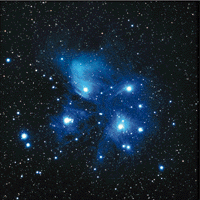IN BRIEF
E = mc2, Really
Converting matter into light is a simple trick compared with the flip side of Einstein's famed equation--or turning light into matter. To do so requires far more energy than physicists have managed to generate in the laboratory. But a team at the Stanford Linear Accelerator Center recently succeeded by aiming terawatt laser light into the accelerator's tightly focused electron beam. Some of the laser photons scattered backward and changed into high-energy gamma-ray photons. These photons in turn collided with other laser photons and produced electron-positron pairs.
Vodka Woes
Between 1984 and 1994 life expectancy in Russia for both men and women rose briefly and then plummeted. In a new study demographers led by D. A. Leon of the London School of Hygiene and Tropical Medicine credit the extra deaths to heavy drinking. The group found that rates of cancer-related deaths held steady during the decade it studied. And although tuberculosis became more prevalent and the health care system changed during the same period--factors that may have affected life expectancy--the incidence of deaths from alcohol-related diseases, accidents and violence rose most dramatically.
The Biggest Star

|
So named for the shape of its nebula, the Pistol Star, hidden away amid dust clouds in the center of the Milky Way, has stunned astronomers with its enormity: it appears to be 100 times larger than the sun and 10 million times brighter. Researchers from the Space Telescope Science Institute and the University of California at Los Angeles first captured Pistol's image in October, using the Hubble Space Telescope's near-infrared camera and multiobject spectrometer, which astronauts installed last year. Now theorists must struggle to reconcile Pistol's seeming size with notions of star formation, which generally do not predict stars that big.
|
Bringing Up Baby (in 3-D)
Researchers at Emory University have discovered by chance that a range of disorders involving three-dimensional vision are developmental in origin. Eye doctors long thought such deficits were genetic because they appeared in children born with cataracts. But when Ron Boothe and his colleagues induced cataracts in rhesus monkeys, none of these 3-D defects arose in infants older than three weeks. Further study showed that the monkeys' brains underwent a major reorganization after three weeks, prompted by environmental stimuli. This reorganization, which occurs at three months in humans, is essential for developing normal depth perception.
Brighter Sunshiny Days
Piecing together data from three satellites, Richard C. Willson of Columbia University reports that the sun may well be getting brighter. Indeed, the total solar irradiance--or the radiant power absorbed by the earth--rose 0.036 percent between 1986 and 1996, spanning one cycle of sunspot activity. If the sun steadily grows more luminous at this rate, Willson predicts that it will warm the globe by about 0.4 degree Celsius in the next century. In comparison, greenhouse gases are expected to heat the planet by about two degrees C in the next 50 to 100 years.
ATCG Puzzle Pieces
Biochemists have long held that weak hydrogen bonds let DNA strands pull apart and zip back together in just the right combinations: adenine molecules pair up with thymine, and cytosine seeks guanine. But Eric Kool of the University of Rochester recently proved that idea wrong. Kool found that geometry--and not hydrogen bonding--ensures accurate replication. To prove it, he made molecules resembling adenine and thymine. These fake bases had the same 3-D shapes as their natural counterparts but could not form hydrogen bonds. Even so, the artificial bases snapped into place as readily--and correctly--as the natural ones during replication.
Mr. McGregor's Revenge
Farmers in New Zealand have set out to rid themselves of crop-eating rabbits once and for all: many are spreading liquefied livers from calicivirus-infected animals over carrots and oats left out as bait. The calicivirus, which has killed countless rabbits on the South Island so far, is used as a biological-control agent in Australia. But in New Zealand the government has banned it. Anyone found guilty of importing calicivirus to New Zealand could face five years in prison and a NZ$100,000 fine.
Evaluation Evaluations
How accurate are student evaluations of instructors? Many university administrators value them enough to consult them in making tenure and pay decisions. But a new study shows that students give the highest marks to the most enthusiastic--and not necessarily the best--teachers. Stephen J. Ceci of Cornell University taught developmental psychology twice one year. In the fall, he gave his lectures as he had for the past two decades. In the spring, he did the same but changed the pitch in his voice and used more gestures. Second-semester students found Ceci not only more knowledgeable and tolerant but more fair, organized and accessible. And they claimed to have learned more, even though they did no better than first-semester students on the same exams.
Jet Chemistry
To cause a chemical reaction, you need heat, light, radiation, ultrasound or, as Kenneth S. Suslick and his students at the University of Illinois have shown, liquid jets. The scientists drove high-energy reactions and broke superstrong bonds by colliding two streams at a combined speed of 450 miles per hour. Water jets, they found, generated hydrogen peroxide and fragments capable of destroying chlorocarbon compounds. For this reason, Suslick suggests that liquid jets might offer a simple way to purify water supplies containing low levels of chemical waste.
--Kristin Leutwyler
